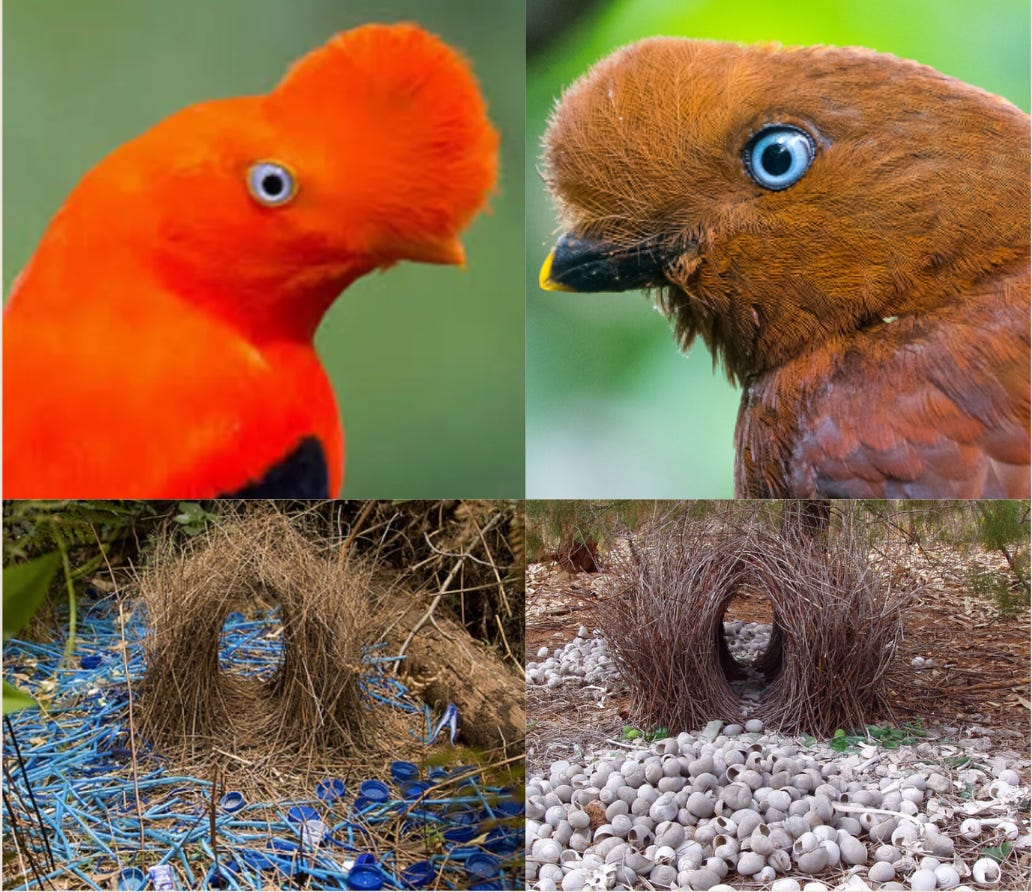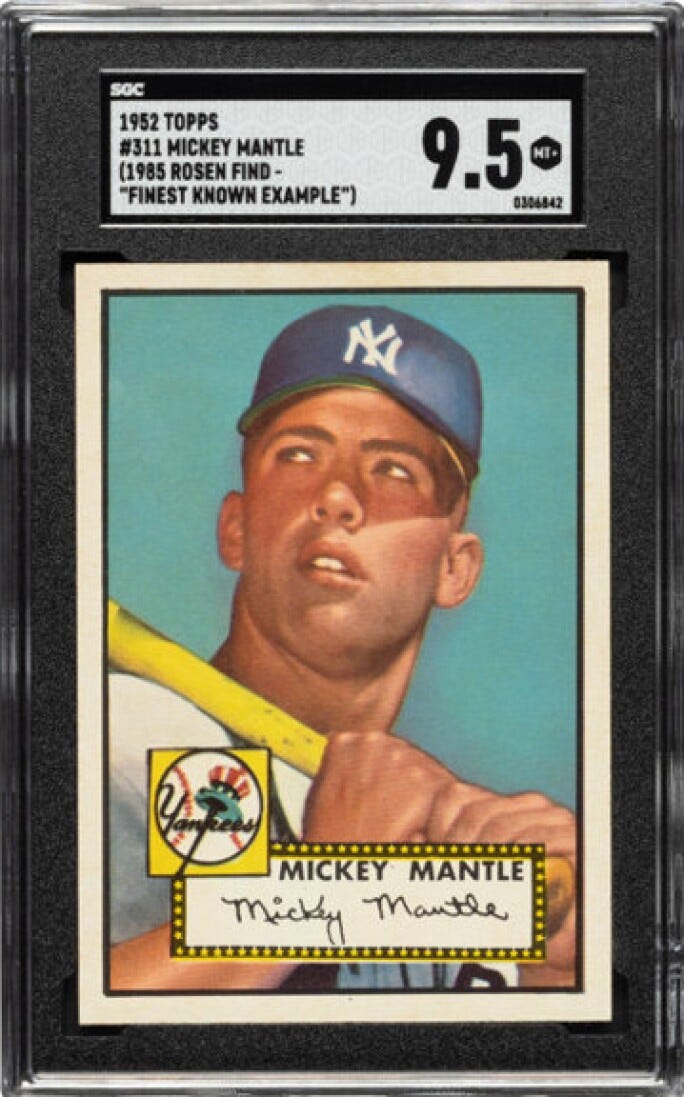Post 17: Runaway Processes
(you really don't have to catch 'em all)
We all know about natural selection and of survival of the fittest (yes, it’s bonkers that so many people still don’t believe in it!) and yet, there also exists a lesser known hypothesis of Darwin’s that hardly anyone knows about, which states that in addition to (this is important — it’s not instead of) natural selection, a parallel and subjective process of aesthetic mate choice by females is also driving evolution in the animal kingdom. In other words, evolution isn’t just about ‘Survival of the Fittest’, it’s also about ‘Survival of the Cutest*!” (Adorbs.)
Survival of the Cutest |
(mostly stuff from the book The Evolution of Beauty - How Darwin's Forgotten Theory of Mate Choice Shapes the Animal World)
As I do with other books, I have been sharing tidbits of information with friends from a book that I have been reading: Richard Prum’s — The Evolution of Beauty, a wonderful, wonderful book… but this time around I have also been (unfairly) catching a lot of flack about sharing “pornographic” materials, which so what if these tidbits have included graphic descriptions of duck sex (did you know the longest recorded duck pecker is 16.5 inches long🙀!) and cloacal kisses… and OK fine, when taken out of context, this could all sound a little pornographic perhaps, but in the larger context of how beauty evolves in the animal kingdom, and how it is that female mate choice is driving the evolution of some pretty wild ‘ornamentation’ (euphemism) in males, these tidbits are nothing short of (and sometimes inordinately long of), utterly mind-blowing!
This process of aesthetic mate choice has a significant impact on evolution because it’s a self-fulfilling (not a euphemism), positive feedback loop, which by definition can also sometimes get out of hand — and when it does, it can lead to the development of not just exaggerated traits in males, but even maladaptive ones of which the male peacock’s tail is the classic example: the unwieldy, OTT broom-of-a-tail had always bothered me in the past because from the perspective of just survival-of-the-fittest, it makes absolutely no evolutionary sense, but throw in survival-of-the-cutest, and … TA-DA! Turns out I was in good company too — it was Darwin himself who once said, “The sight of a feather in a peacock's tail, whenever I gaze at it, makes me feel sick.”
As to why hardly anyone knows about this hypothesis, that’s because the hypothesis was expeditiously snuffed out… two reasons per Prum: 1. the idea of females driving the evolution of beauty in males was enough to cause the pouffed heads of the then Victorian powers that be (were?) to explode, and 2. it poked serious holes into the assumed correlation between “attractiveness” and fitness of genes, which formed the entire basis of the “science” of eugenics, a very popular doctrine of the time.
And yet, although Darwin’s hypothesis stated that cuteness is arbitrary, still —
“Arbitrary does not mean accidental, random, or unexplainable; it only means that the display trait communicates no other information than its presence. It simply exists to be observed and evaluated.” — Richard Prum, The Evolution of Beauty.
Beauty for the sake of beauty.
And it doesn’t even end there… aesthetic mate choice has also led to the development of some extreme and elaborate courtship rituals in birds e.g. an alpha male long-tailed manakin prepares for years to perfect a courting duet that he performs with a beta male (who poor chap, his only hope is to succeed the alpha someday for a shot at copulation). And then there are the bowerbirds who true to their name build elaborate bowers inside forest clearings to attract females, which they decorate with a kleptomaniacal zeal (most species even have a single-minded preferred color).
Top: A male cock-of-the-rock flaunting its bright plumage and mohawk, and a female who has no need for all the ornamentation. Bottom: two bowers of bowerbirds, one with a penchant for Aquafina bottle caps, and the other for the killing fields of Cambodia:
The female bowerbird evaluates the male song-and-dance from inside the bower, and if she is not impressed, she simply flies away… sometimes even before the performance is over. And I know, I know you are feeling very sorry for the male birds, but before you shed any tears, let me tell you about the dark driving force behind the mating rituals, which is that the bowers are less condos built to please the eye, and more condoms to protect females from ‘forced copulations’ (definitely a euphemism). Yes, mate choice by females is all about no-means-no, and therefore about selecting traits in males that indicate ‘safety’… of course that is until the positive feedback loop gets out of hand and then safety means whatever the heck safety/beauty means to the females of the species — which if you happen to be peahens with exhibitionist proclivities, then that evidently means a tail with a hundred eyes. Side note: in humans, this safety-first evolution has led to smaller differences in male vs. female body sizes, weaker jaws, man buns, etc. (when compared to apes).
Endnote: The book also says that natural selection and sexual selection don’t share the same goals (fitness vs. beauty… the operative word is vs.) but as evolution moves along, a point of compromise is reached between these opposing goals. In the author’s words: the male may still be quite far from the natural selection optimum but that’s the cost of doing business with sexually autonomous, choosy females. Indeed, it is quite clear that it’s a point of compromise that has been reached in human males, and as such, to the patriarchs of society, I say — check-mate (not a euphemism, not such a great pun either).
Here’s Prum speaking about all this at a TedX (at least watch the amusing courtship ritual of the male Superb Bird of Paradise at ~8 mins, and a Manakin using wing-farts to impress at ~12 mins):
Trading Cards, Tulips, and other nonsense |
I watch a lot of mindless OTT content, and recently that has included King of Collectibles: The Goldin Touch on Netflix. The show is about a Ken Goldin person who makes a ton of money auctioning all things inherently worthless, including what are called ‘trading cards’. These look just like playing cards, but have photos of sportspersons printed on them along with their signatures (some original, some not). And from what I could gather, the way all of this works is that some “official” corporation or corporations prints these cards, and then people trade them simply because they are called trading cards. (I wonder what would happen if I printed some cards with random numbers on them and called them let’s see… money cards?) To make things more interesting, and by which I mean to rig the system, these mystery corporations also print very few of some cards ipso facto making those cards even more valuable. How valuable you ask? Sotheby’s lists this 1952 baseball card as being sold in 2022 for USD12.6 million — not on my mantle!
This is clearly yet another example of a positive feedback loop gone wrong, but I give full props to Ken Goldin for capitalizing on the madness: gold-in, gold out; he seems like a nice guy too. Like all other runaway processes, the more the people that buy into the madness, the more valuable the cards become, and judging by the Ken Goldin’s private jet, the more people are clearly buying into the madness.
Runaway processes have a long human history too — ‘tulip mania’ happened way back in 17th century and at its peak, 12 acres of land were offered for a single Semper Augustus tulip bulb per wikipedia. A much more contemporary craze is that of the Stanley water bottles in America — people are lapping these bottles up at premium prices like they are going out of style — mostly because they are going out of style as the company keeps releasing limited edition bottles that become more valuable simply because the company makes very few of them… you get the idea. And yet, although this playbook has been played out over and over and over again, people in America are still tripping over each other to buy them. At least one hopes that they are well-hydrated when they fall; (SPLAT).
The Runaway Trolley Problem |
This classic philosophy, ethics, psychology 101 problem in its original form involves a trolley hurtling down a track on which are standing five unwitting people who will most certainly die unless the course of the trolley is changed, which you can do using a lever — if you pull it, the trolley will change course and kill just one man instead who is standing on an alternate track. The obvious choice is between killing the one vs. the five people (the utilitarian choice), but then there is the issue of actively participating in killing someone vs. not. Also there are many variations that add complexities to the choice — the most well-known one substitutes the lever with a throwable-fat-enough-man (sigh) standing on a bridge whom you can push to alter the course of the trolley.
Now, this is where one would normally fall into a discussion of all the variations and their moral and ethical implications, but I won’t because for me, it all boils down to just one thing — Determinism… a philosophy so dear to my heart that I really thought I would have introduced it with a little more fanfare and yet, as a believer, I know that there was no other way it could be. Just as whatever one chooses in the trolley problem, there was no other way that could be. Determinism claims that all of our actions, with no exceptions, are simply a consequence of our genes, our pre-conditioning, and our environment, and as disconcerting as that may sound at first (especially if you are a republican — no personal responsibility… whaaaat?), if you read about it with an open mind, you will see that it’s the only thing that makes sense. Personally, I am so sold on the idea that it’s the only tattoo I have ever have considered getting —Determined… not because I am, but in honor of both the philosophy, and of the book Determined by Robert Sapolsky, a very, very brilliant book indeed.
PS: Where the trolley problem will pose an actual choice is with self-driving cars who will face decisions like these, and it is up to us humans to code the ethics of these choices into their algorithms. Of course, determinism tells us that although these “autonomous” cars will make their choices based on what we code into them, yet what we end up coding into them is not something that’s under our control. (Or what we code into them was coded into us by someone else — but that’s definitely a topic for another post on another day!)
Lastly, if things were left to women (as they should be), and it came down to saving either the tiny Ant-Man on one track, or the Incredible Hulk on the other, we all know who the ladies’ choice would be.
(Whatever, bite me!)





Reminded me of a book - The genius of birds by Jennifer Ackerman